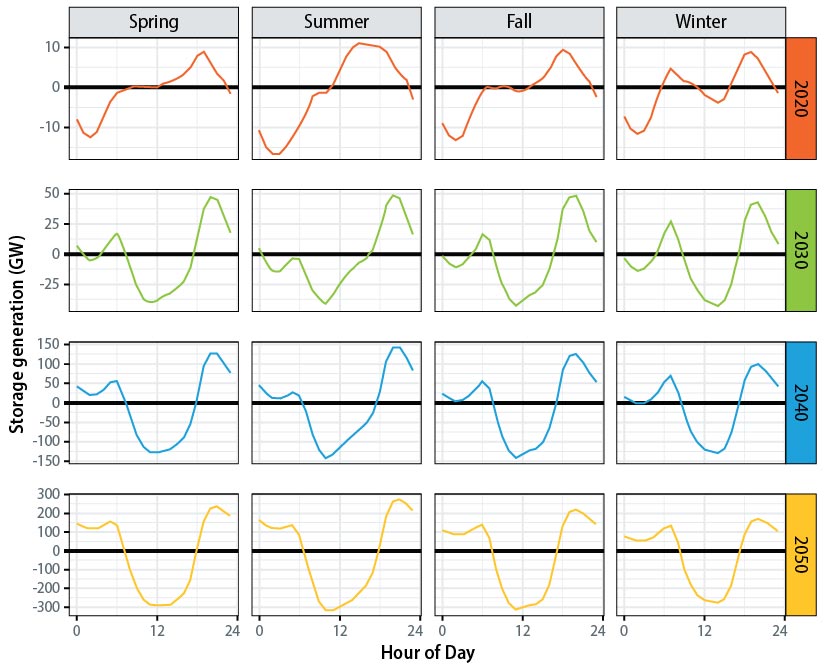Storage Futures Study: Key Learnings for the Coming Decades
Multiyear Study Concludes With Key Learnings Across the Series, All Indicating Rapid Growth of Energy Storage
Energy storage will likely play a critical role in a low-carbon, flexible, and resilient future grid, the Storage Futures Study (SFS) concludes.
The National Renewable Energy Laboratory (NREL) launched the SFS in 2020 with support from the U.S. Department of Energy to explore the possible evolution of energy storage. The series kicked off with a visionary framework for increasing energy storage deployment and duration over time and studied questions set forth in the vision across five subsequent reports. Key learnings from the entire series are synthesized in a final report.
"Each phase of the study has indicated a potential coming wave of energy storage, with U.S. installed storage capacity increasing by at least five times by 2050," said Nate Blair, principal investigator of the study. "Overall, we find energy storage offers significant value, from easier grid operations to fewer costly thermal start-ups to reduced emissions."
High-Resolution Modeling of Future Scenarios
To understand what drives energy storage deployment and how it could impact the grid, NREL modeled hundreds of future scenarios. Researchers added new capabilities to NREL's publicly available Regional Energy Deployment System (ReEDS) capacity expansion model to accurately represent the value of diurnal (<12 hours) battery energy storage—an inherently complex modeling challenge.
ReEDS created a robust set of future high-storage power system scenarios with different cost and performance assumptions for storage, wind, solar photovoltaics (PV), and natural gas. To simulate grid operations in the ReEDS scenarios, NREL used a commercially available production cost model (PLEXOS).
On the distribution side, NREL added new storage capabilities to its open-source Distributed Generation Market Demand (dGen) model to simulate customer adoption of solar-plus-storage systems under different battery and backup-power value assumptions.
Together, the model enhancements opened the door to exploring many new research questions about energy storage on the future grid.
Storage Could Be a Major Part of the Least-Cost Grid Mix
Across all modeled scenarios, NREL found diurnal storage deployment could range from 130 gigawatts to 680 gigawatts in 2050, which is enough to support renewable generation of 80% or higher.
"We found energy storage is extremely competitive on an economic basis, and there are rapidly expanding opportunities for diurnal storage in the power sector," said Will Frazier, lead author of Storage Futures Study: Economic Potential of Diurnal Storage in the U.S. Power Sector.
Lithium-Ion Batteries Will Likely Be the Fastest Growing Storage Technology
NREL examined 15 energy storage technologies at various stages of commercialization. Ignoring cost, most of these technologies could support the grid with either short or long durations.
However, rapid declines in lithium-ion battery costs make it the most attractive energy storage technology. Lithium-ion battery pack costs have dropped an astounding 80% over the past decade and are expected to continue to fall, driven largely by electric vehicle demand.
Learn more in the Storage Futures Study: Storage Technology Modeling Input Data Report.
Grid Operations With High Levels of Renewable Energy Improve With Lots of Storage
Several phases of the SFS showed energy storage can provide the most value in helping meet peak demand—which is closely connected to PV generation.
More PV generation shifts peak demand to later in the day and shortens it to a few hours, which increases the value of shorter-duration storage. As modeled, the value of storage increases over time as load grows and existing generators retire.
"High-storage power systems can successfully balance load 24/7," said Jennie Jorgenson, NREL analyst and lead author of Storage Futures Study: Grid Operational Implications of Widespread Storage Deployment." The modeled energy storage assets don't run all the time throughout the year but turn on during the 10 highest-demand hours of the day when the power system needs capacity the most."

Costs Declines and More Opportunities To Provide Backup-Power May Drive Increased Adoption of Building-Level Storage
NREL also found significant potential for distributed storage on hundreds of thousands of buildings.
The deployment potential varies by location based on specific rate structures or incentive programs but is generally driven by battery costs and the value of backup power.
"The process of developing and implementing distributed storage technology within our dGen model revealed additional questions and needed research capabilities related to behind-the-meter battery storage adoption," said Ashreeta Prasanna, dGen modeler and lead author of Storage Futures Study Distributed Solar and Storage Outlook: Methodology and Scenarios—the first-ever published estimates of distributed battery storage deployment. "Additional enhancements of dGen will be needed to explore research questions such as the adoption potential of community-scale distributed energy resources (DERs) and storage capacity and their impact on the distribution grid, exploration of the trade-offs between distributed and utility-scale storage, and the role of DERs in supporting the transition to a decarbonized economy."
Join May 10 Webinar To Learn More
For the complete list of key learnings from across the entire Storage Futures Study, read the final summary report and join a free webinar from 12 to 1 p.m. MT on Tuesday, May 10, 2022, to hear from SFS researchers.
Visit the Storage Futures Study page for more information about the broader study, and learn more about NREL's energy analysis research.
Last Updated May 28, 2025
